Original source: Dimension Tech
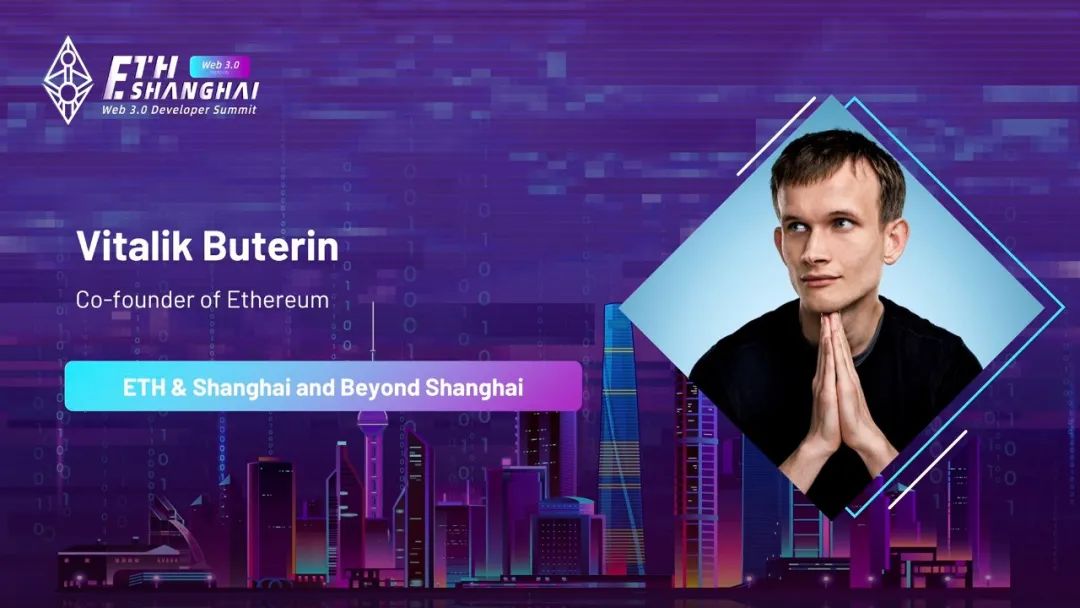
Original source: Dimension Tech
At the Ethereum Shanghai Web 3.0 Developer Summit (ETH Shanghai Summit), hosted by Mask Network, co-organized by China Biodiversity Conservation and Green Development Foundation and Business China, and sponsored by the Ethereum Foundation, Ethereum co-founder Vitalik Buterin Delivered a keynote speech titled "ETH & Shanghai: Mutual Shanghai and Outside".
The following is the full text of the speech:
Today, I want to talk about the latest changes in the Ethereum protocol at the Ethereum Shanghai Summit. I know that many people want to know the news that Ethereum is merging PoS (Proof of Stake) with the existing PoW (Proof of Work). And in addition to the Ethereum ecosystem and applications, what other improvements are taking place.
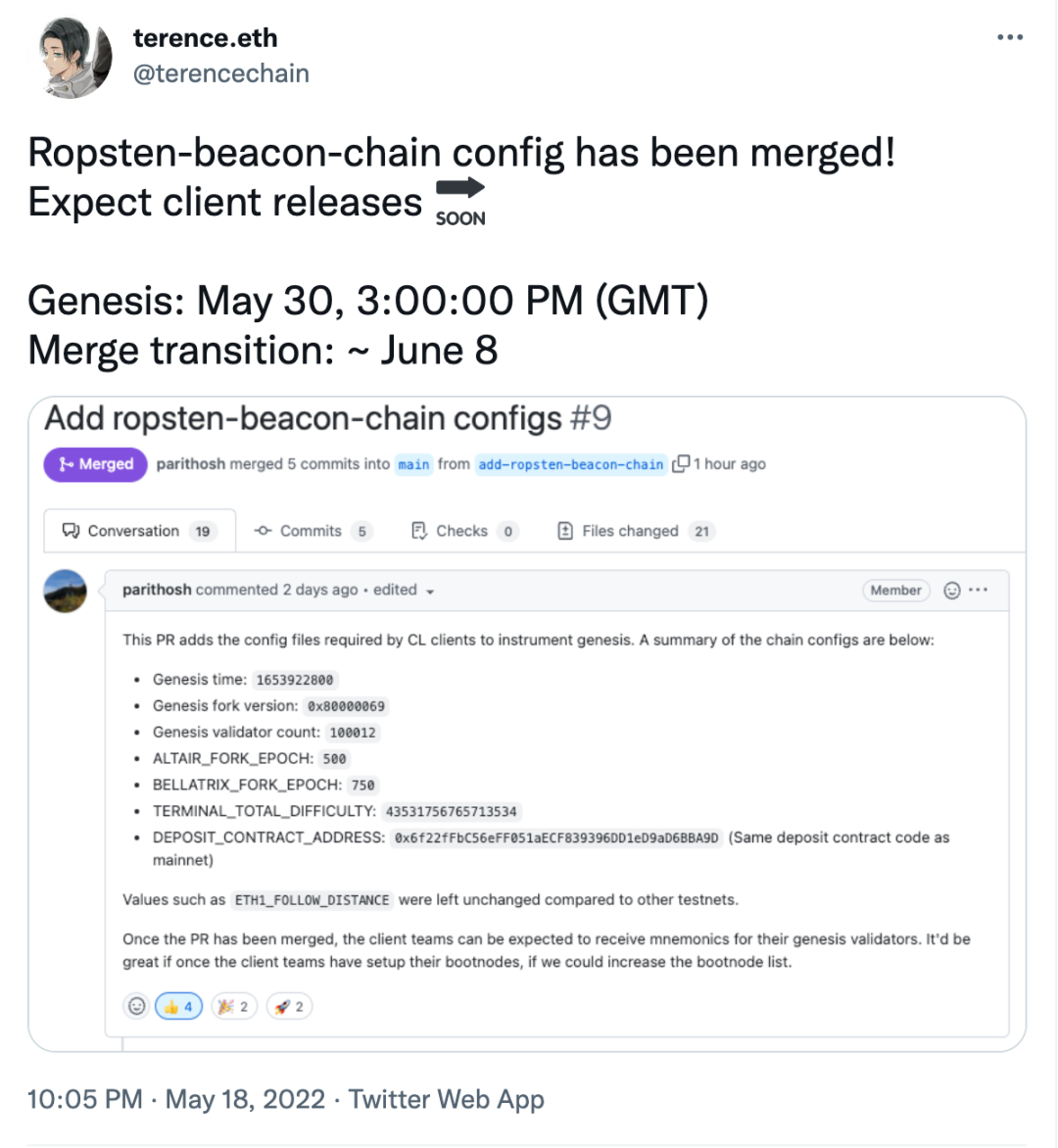
The main topic today is "Merge". "Merge" refers to the transition from the original PoW consensus mechanism to the PoS consensus mechanism. We've been working on switching between the two almost since the beginning of the Ethereum project. We've spent 7 years on "merging". Up to now, all the efforts have gradually paid off, and we have performed a "merge" on the Ethereum test network Ropsten a week ago. By June 8th, we'll be done, and if all goes well on the testnet, we'll be "merging" on the mainnet this summer. This is our next major move, and the biggest we've done so far, which will lay the groundwork for any future "mergers" of on-chain applications.
If nothing else, the "merger" should begin in August. However, of course, there may be problems in the test, and the "merge" on the mainnet may also be delayed, and it may not start until September-October. But the time for the "merger" is approaching. We should think about what will happen after the final "merger"?On this point, I published a paper on protocol updates in May to illustrate.
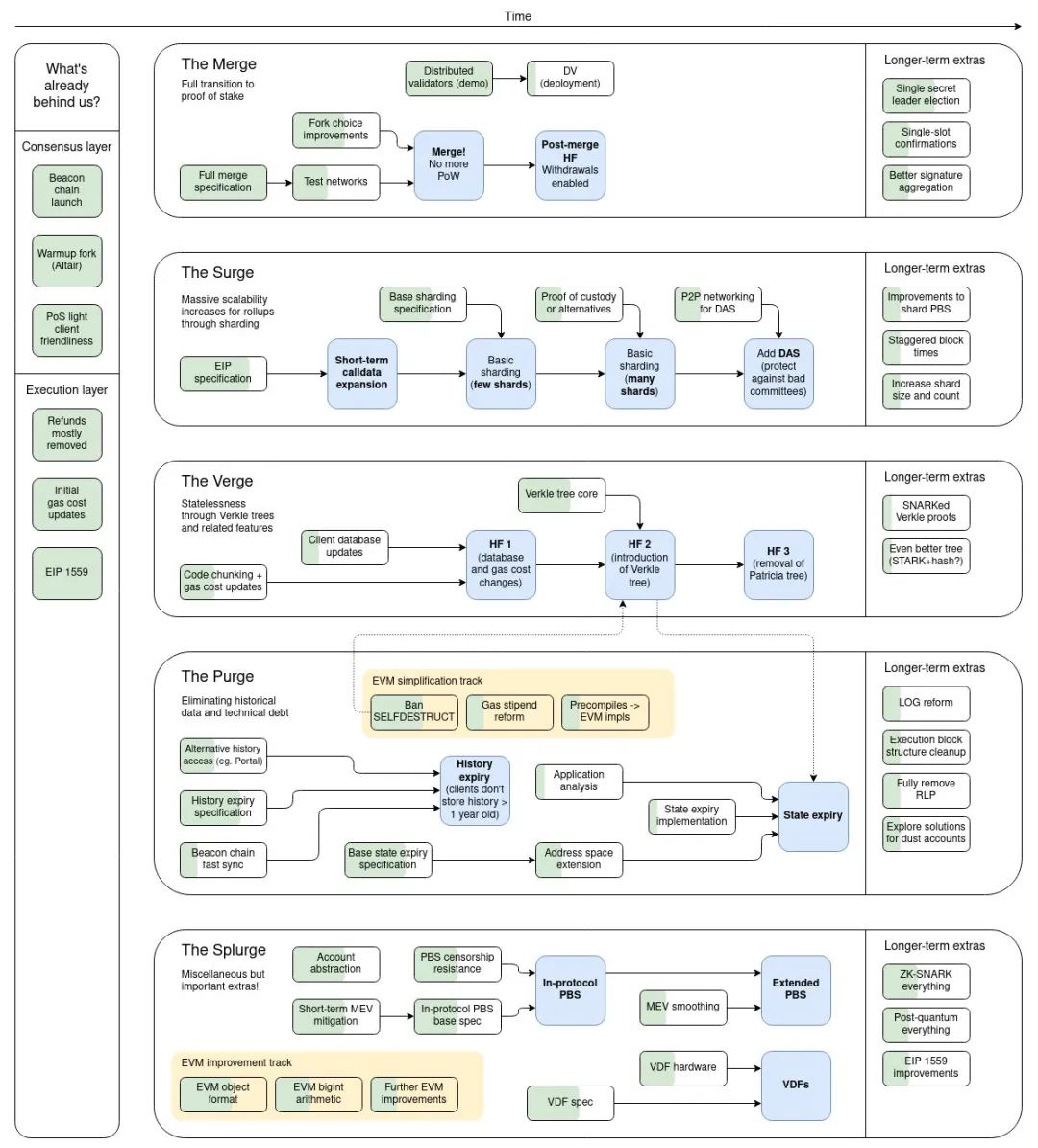
These things have been around for a long time among Ethereum developers, and Beacon Chain and PoS have been in their hands for a year and a half. In fact, there may already be a small number of users in the beacon chain. EIP-1559 is also now operational. In the next few years, there will be many new changes. For your convenience, I will divide them into five parts, namely Merge, Surge, Verge, Purge and Splurge.
"Merge" is the switch from PoW to PoS. And Surge is a kind of sharding in order to increase scalability by processing a huge amount of transactions through rollups. To this end, we designed EIP-4844 (Proto-danksharding). I think there are a lot of different ideas about capability sampling for sharded data. For example, The verge can switch the Verkle tree, which can make the Ethereum nodes run more efficiently. In this way, even if your computer configuration is not high, you can still easily become a validator, making the protocol more decentralized. This can make it easier for more people to verify that they are part of the Ethereum chain. In the process of "merging", there will be a lot of positive feedback.
For example, Purge can improve the efficiency of operation by canceling the permanent storage of all historical block information. For example, node service providers do not need to store all the data in the block, they only need to store the data for nearly a year, some data that has not been accessed for a long time will be placed in another storage space, and the node does not need to store They are gone.
Some parts of the Ethereum protocol are too complex, which makes it more difficult to create Ethereum nodes, they can be removed from the Ethereum protocol, and then can be simplified by Splurge which contains a lot of important information. And one more, on the virtual machine update, there's a concrete solution, which for us means we're going to spend a little longer talking about our thoughts.
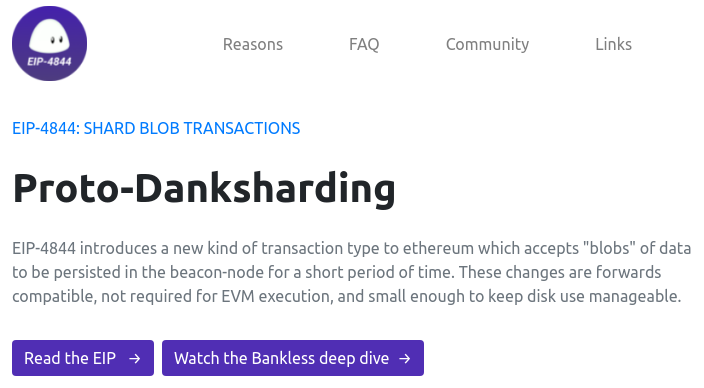
In short, there are many changes that will happen next. I don't think everything has to happen, so if we don't have any surprises after the "merge", Ethereum is still a good system. In other words, I think Ethereum would be a much more perfect system if we managed to "merge". The first big thing after we did the "merge" was EIP-4844. What deserves our attention in the near future is the improvement of the scalability of the entire Ethereum by sharding.
Recently, there have been many changes and simplifications in the design of the sharding roadmap, and I have some ideas about Danksharding. It was released at the end of last year, and dankSharding really made the roadmap for sharding easier. In the past, there were 64 proposers for 64 shards, however in practice this would lead to a lot of duplication being confirmed which in turn would lead to market centralization, but in darksharding only one proposer chooses all transactions and all data. The main feature introduced by EIP-4844 is a new transaction type, which we call transactions with blobs. A transaction carrying a blob is similar to a regular transaction, except that it also carries an additional piece of data called a blob. Blobs are very large (~125 kB) and are much cheaper than calling data for a similar amount. However, the EVM execution cannot access the blob data; the EVM can only see the promises to the blob. Because validators and clients still need to download the full blob content, the data bandwidth target in EIP-4844 is 1 MB per socket instead of the full 16 MB. However, since these figures do not compete with the gas usage of existing Ethereum transactions, there are still large scalability gains. Projects like Arbitrum, Optimism, Stark Net, Polygon, Rollups could all benefit greatly from EIP-4844. Let more and more developers flock to them, and they get better and better. Currently EIP-4844 is only the first step of Danksharding, all nodes still need to download all data, but it has completed a lot of work of Danksharding. Although it cannot handle 16M data, it can still handle 1M data, which is a great improvement. We've done a lot of work on this, and a lot of work will continue over the next six to nine months or so. I think EIP-4844 must be a very important ecosystem. I'm looking forward to its progress.This is the content of fragmentation, let's continue to talk about itAccount Abstraction
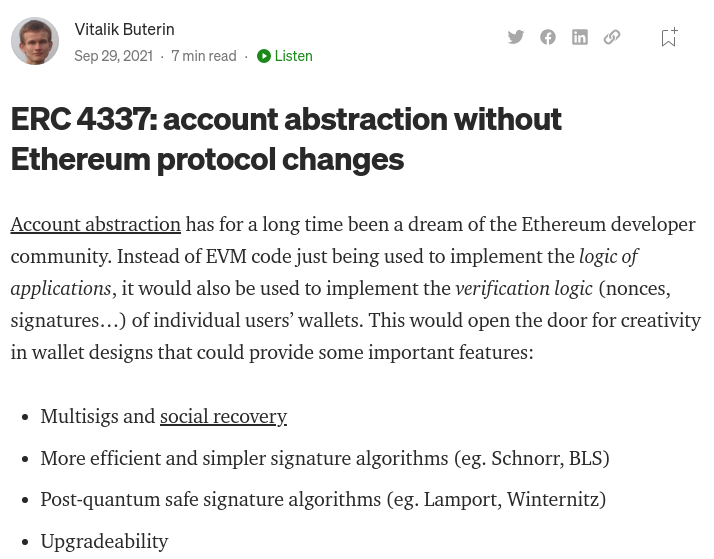
. Account abstraction is currently just an idea of mine, which allows each user to arbitrarily create accounts for their wallets, and these accounts are protected by a complex set of rules behind them.
For example, you now only have one wallet and one private key. If the private key is stolen, the wallet assets will be cleared. So what if you have an account with three private keys? If one private key is stolen, it’s okay, you still have two. If you lose another one, it's okay, hackers can't do anything with these two private keys. You can still use the last private key to make emergency changes to other accounts.
This example may be a bit troublesome, but abstract accounts are actually more convenient than this. It can provide many functions, such as: multi-signature and social recovery, allowing you to recover your attacked account more conveniently;
A more efficient and simpler signature algorithm helps your account resist hacker attacks and makes the account itself upgradeable. To achieve this, we developed the ERC 4337 protocol. ERC 4337 is not an EIP, it is an ERC, which means that it does not need to provide the basic principles and technical specifications of the technology. In fact, it is already possible to use ERC 4337 to create accounts and send transactions, and there is a developer community already working on ERC 4337. I hope they can improve ERC 4337 faster, and you as developers and users can also join in.Verkle Treewe should almost talk
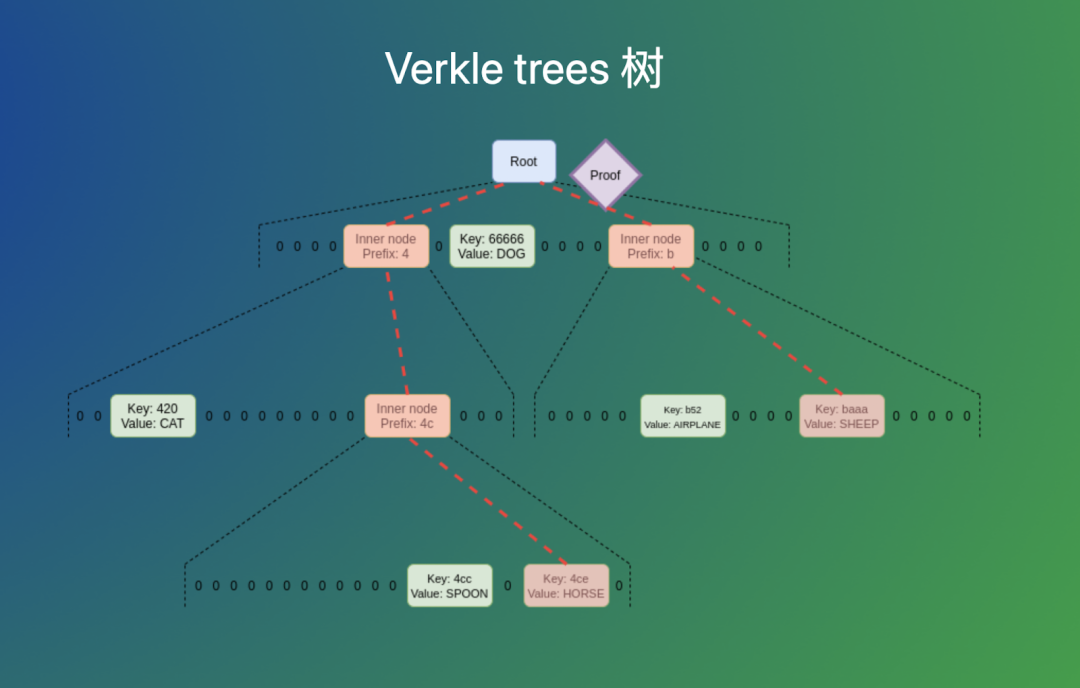
Well, the Verkle Tree upgrade basically lets you verify Ethereum blocks without requiring any hard drive space. Currently, if you want to validate an Ethereum block, you have to have complete information about the block, which is about 40-50 GB in size; and you have to validate it in order. And Verkle Tree will make it easier to verify a single block without any additional information. So this makes it more convenient to have a client that validates every Ethereum block without requiring hard drive space. You can also verify blocks in any order, and Verkle Tree makes it easier for more and different users to run nodes, which is an improvement on decentralized security.MEV solutions.

I think MEV is increasingly being recognized as a big problem to deal with like Ethereum. MEV is allowed, which means that miners or PoW recorders can reorder, insert or review transactions in the blocks being generated, and gain profits from Ethereum users because they have complete autonomy over the blocks. The challenge of solving MEV is how to design an ecosystem to prevent PoS from becoming centralized. There's a lot of work going on here, and I've come up with an idea called the proposer/developer split. Anyone who wants to know more about this, can check out this article (https://notes.ethereum.org/@vbuterin/pbs_censorship_resistance). This is a new idea, and this long-term direction is mentioned in PoS.This is another new idea that has been proposed forPoS makes some long-term modifications
. One of the big changes is single-slot finalization, which enables blocks to complete transactions in one slot instead of 64 slots as they do now. This enables faster transaction results, while making the protocol simpler and resistant to MEV attacks. Although very early trials, there is a lot of research going on. This is something that will take a long time to achieve, and maybe you will see results in three to five years. It is also a great improvement to the operating mode of Ethereum, making Ethereum simple, interesting and worthy of attention.
One of my thoughts on the Ethereum ecosystem is that the encrypted space, including the Ethereum space, pays too much attention to the application of financial attributes today. I think the application of financial attributes is good and important, but they also have a lot of risk. I think that when people continue to try to develop and optimize financial applications, it will also bring great risks. Some of the early DeFi ideas in the past two years are actually great, such as MakerDAO, and the early stablecoin ideas are all great. But I think some of their recent ideas about wanting to improve DeFi protocols are too much for me to favor. Take the recent Luna and UST for example, they just said, "Oh, you need collateral to get a stablecoin, let's create a stablecoin that doesn't require collateral." Of course they did, and they successfully ran in the bull market For two years, prices continued to rise. But now that the price of Bitcoin and Ethereum has dropped, Luna has completely collapsed, and many people have lost a total of more than tens of billions of dollars.
I think the reason why many people are interested in DeFi originally comes from dissatisfaction with traditional finance and the systemic collapse of traditional finance in 2008. This shows that the financial system is too eager to pursue efficiency and neglects better resilience and stability in very special times. But unfortunately DeFi has gone too far in that direction. I think the problem is that, like more innovation in finance, it just creates something riskier. Even if they are like our Uniswap V2 and Uniswap 3, the way they work is only slightly improved. But it seems that the difference between Uniswap V2 and Uniswap V3 is not that big, right? Do you know the difference between Uniswap V3 and Uniswap V4? I think it will be smaller, like having better DeFi, I think that will improve. But it doesn't like massive changes to radically change the world. I think people are in crypto because they really want to change the world and do something big. And I just don't think there's that much of a big impact on financial applications, I think it makes more sense for more developers to start focusing on other areas. I think DeFi is good, I think we really need our own DeFi, and beyond that, we need something more, like blockchain non-financial applications.
Soulbound tokensOne of the applications I'm excited about is Sign in with Ethereum. Basically, whether it is a dApp or an App, you can log in with an Ethereum account. Even if you go to a chat site like chat.blockscan.com, it's a centralized chat app. But you can still log in with an Ethereum account, which is something more and more services are adopting, and we expect to see more services using Ethereum as a login method. In my opinion, Ethereum login has many advantages over centralized login. First, it's not connected to any centralized identity, so you're in control of your account. Your account can't be blocked just because a company wants to, it's very data sovereign, you can own your identity in this way. But it also has a grid effect, it's connected to the open ecosystem, which means that if you log in with your Ethereum account, you are also logged in with your ENS domain name. You can verify that you have a Humanity profile (prove of human), POAP, NFT, or verify everything else. All these applications that people are building on Ethereum can really connect to each other, which I think is a very exciting feature.
, which is an idea that I've been talking about, it's going to start this year. This idea, we like more than tokens that are not transferable at will. These tokens have great value when creating transactions, but there is no way to transfer these values, because these values are already bound to your identity. You own it, but you cannot transfer it, trade it, or rent it out. This is a technical problem we are currently overcoming. I thought of some things we can do, and some ways to make money through tokens. Therefore, Soulbound tokens make identity and reputation meaningful, and make decentralized governance more possible. Any application of a non-financial nature can benefit greatly from it.
We already have DeFi, I think we may see DeGov. Optimism is a project that I am personally very interested in, because I think it pursues a concept that I am very concerned about - no longer token-based governance.Like today's popular DAO, the main governance method is voting based on tokens. If you have ten times more tokens, you can vote ten times more. I have written a lot on this topic. I think the current voting governance model actually has many problems and limitations. Therefore, when voting with governance tokens, they also take a lot of risk while gaining benefits.If we were in this model of non-token-based, non-transfer citizen governance and bicameral governance, we would have to talk to each other and negotiate with each other to make significant changes.
This is a long-term governance experiment, and I think there will be considerable opportunities as more governance experiments and DAOs are born. We can see that many various DAOs, like VitaDAO, are doing research on longevity. I think these should be regarded as "scientific DAOs"-decentralized science. We can see the continuous development of DAO in various fields. I am really happy to see the continuous development of DAO governance towards privacy protection.We already have apps like TornadoCash to keep funds private, but I thinkPrivacy-preserving non-financial applicationsmore interesting. MACI This is a privacy-preserving voting system that we've been developing for over two years and have made a lot of progress.Privacy Preserving Reputation System, UniRep Social
, In fact, there are many privacy protection applications based on zero-knowledge proofs that developers are working on, and these applications have made good progress. If people want to get involved in developing and building today, I think it would be a good idea to build in these non-financial applications, or in the category of applications that can combine financial and non-financial properties.
A lot of interesting things are happening in the Ethereum protocol, for example, there are many exciting improvements in the consensus layer of Ethereum. But it is also necessary to talk about the ecosystem of Ethereum. One of my big thoughts on the ecosystem of Ethereum is-I think the currency circle, including the Ethereum community, is paying too much attention to financial applications at this time, although financial applications Also very important.
I think that in the future, most of the work will be carried out in higher layers, so the core improvement of Ethereum is very important, but in the application field, ecosystem, bottom layer or second layer protocol, Ethereum address Logging in, privacy... these things will become more important. I think in the future we should see more good applications and focus more on non-financial applications. I hope this inspires developers working on these ideas. The ecosystem of Ethereum is huge, and there are still many interesting things to learn and research. Today there are more tools than ever that allow people to accomplish amazing things. I'm excited for all kinds of things people can create in the future!